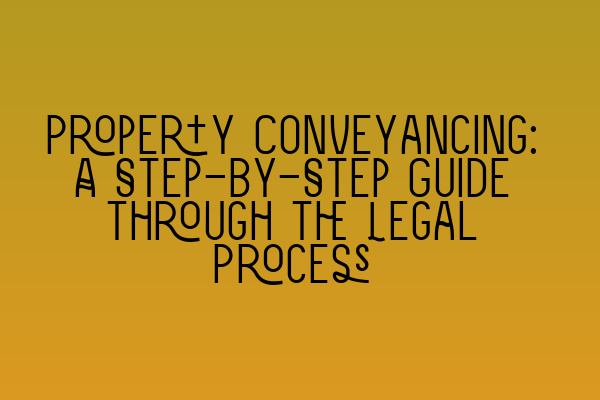Property Conveyancing: A Step-by-Step Guide through the Legal Process
Buying or selling a property can be an exciting yet complex process. It involves numerous legal procedures that need to be followed to ensure a smooth transaction. This step-by-step guide will walk you through the property conveyancing process, providing you with a clear understanding of what to expect.
Step 1: Instruction
The conveyancing process begins with the instruction of a solicitor. Once you have chosen a solicitor, they will require certain information from you, such as your identification documents, proof of funds, and details about the property. This information is necessary to initiate the legal process.
Step 2: Searches
The next step in the conveyancing process is conducting searches. Searches are performed to gather information about the property and its surroundings. These searches can include local authority searches, environmental searches, and drainage searches, among others. The purpose of these searches is to uncover any potential issues or restrictions that may affect the property.
Step 3: Reviewing the Contract
Once the searches are complete, your solicitor will review the draft contract supplied by the seller’s solicitor. They will carefully examine the terms and conditions of the contract, ensuring that it is fair and in accordance with your requirements. Any necessary amendments or clarifications will be requested.
Step 4: Mortgage Offer and Survey
If you require a mortgage to purchase the property, your lender will carry out a valuation survey to assess the value of the property. This survey is conducted to protect the lender’s interests. It is recommended to also arrange a more detailed survey, such as a homebuyer’s report or a full structural survey, to identify any potential issues with the property. Once the mortgage offer is received, your solicitor will review the conditions stipulated by the lender.
Step 5: Exchange of Contracts
The exchange of contracts is a crucial milestone in the conveyancing process. At this stage, you and the seller become legally bound to complete the transaction on a specified completion date. Before exchanging contracts, your solicitor will ensure that all necessary checks have been completed, and all parties are ready to proceed. Once contracts are exchanged, a deposit is paid, usually 10% of the purchase price, and a completion date is set.
Step 6: Completion
On the agreed completion date, the balance of the purchase price is transferred from your solicitor to the seller’s solicitor. This is usually done through the bank transfer system. Once the funds are received, you will receive the keys to the property and become the legal owner. Your solicitor will also settle any outstanding fees and taxes, such as Stamp Duty Land Tax, on your behalf.
Step 7: Post-Completion
After completion, there are several post-completion tasks that need to be completed. Your solicitor will register the change of ownership with the Land Registry and update the title deed. They will also provide you with a copy of the updated title deeds and any other relevant documents relating to the property.
Conclusion
Property conveyancing can be a complex process, but with the guidance of an experienced solicitor, it can be completed smoothly and efficiently. By following this step-by-step guide, you now have a better understanding of what to expect during the legal process of buying or selling a property.
If you’re preparing for the SQE exams or looking for practice exams and courses, check out our related articles:
– SQE 1 Practice Exam Questions
– SQE 1 Practice Mocks FLK1 FLK2
– SQE 2 Preparation Courses
– SQE 1 Preparation Courses
– SRA SQE Exam Dates
At SQE Property Law & Land Law, we are committed to providing expert legal services and comprehensive support to ensure a successful property conveyancing process. Contact us today for assistance with your property transaction needs.
Note: This blog post is designed to provide general information and should not be considered as legal advice. Consult with a qualified solicitor for personalized advice based on your specific circumstances.
